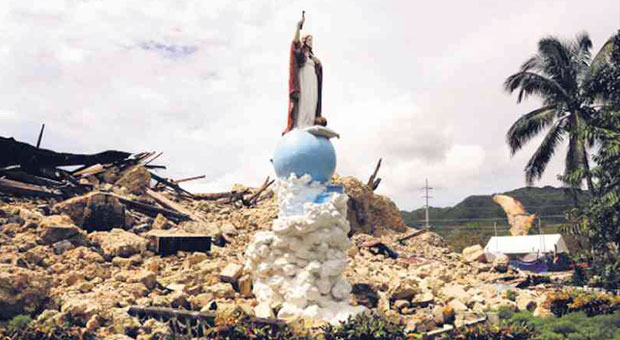
UNSCATHED A statue of Christ the King, once dwarfed by the facade of Maribojoc Church, survived the powerful earthquake. ESTAN CABIGAS/CONTRIBUTOR
(First of three parts)
TAGBILARAN CITY, Philippines—“I can accept the idea that maybe a few of these churches might just be left as ruins, never to be rebuilt,”Bishop Leonardo Medroso, head of the Diocese of Tagbilaran, said. “But others are going to be restored.”
It has been almost a year since the so-called Great Eastern Bohol Earthquake damaged many churches in Medroso’s diocese and already he is overseeing the construction of alternative churches beside the ruins of what were once considered jewels of Spanish missionary architecture in Bohol province.
Twenty-five of the province’s churches—10 of them built by Jesuit and Recollect missionaries during the Spanish period—were either destroyed or suffered varying degrees of damage.
Priceless objects and artifacts in the parish museums of Loboc and Maribojoc towns were not spared.
Nearby Cebu Island fared a little better, as only eight churches were damaged, the worst being the damage to the belfry of Basilica Minore del Sto. Niño, which was dramatically shown on social media.
Heritage agencies respond
Within hours of the earthquake, the Board of Commissioners of the National Commission for Culture and the Arts (NCCA), the country’s equivalent of a Department of Culture, immediately convened in Manila with Fr. Milan Ted Torralba, the executive secretary of the Permanent Committee for the Cultural Heritage of the Church, the heritage arm of the Catholic Bishops’ Conference of the Philippines, attending the meeting.
The NCCA board counts among its members National Museum director Jeremy Barns, National Historical Commission of the Philippines (NHCP) Chair Maria Serena Diokno and National Archives of the Philippines Director Victorino Manalo, all of whom are no strangers to the task ahead insofar as historic and heritage structures are concerned.
Two days later, on Oct. 17, 2013, Torralba, who also heads the Commission for the Cultural Heritage of the Church in the Diocese of Tagbilaran, met with Barns and National Museum officials together with staff from the NHCP to see the extent of damage in Baclayon and Loboc towns as well as in the municipalities of Loon and Maribojoc.
Maribojoc and Loon were cut off from the capital, Tagbilaran, with the collapse of the Abatan Bridge. Torralba had to hire two pump boats to bring the team to the site.
The team saw Bohol’s largest Recollect church, which once stood proudly amid a vast expanse of open space in Loon, was now nothing more than two piles of coral rubble.
BEFORE The majestic, heritage church of Maribojoc as it looked before the earthquake reduced it to ruins one year ago. ESTAN CABIGAS/CONTRIBUTOR
Christ the King statue
The church in Maribojoc, also built by the Recollects on a low hill, suffered the same fate, with only the statue of Christ the King left standing, showing not a crack or any sign of the tremendous stress that reduced the church behind it to rubble.
The parish church of Loboc, located a few meters from a deep, wide river, still stands. But it had lost its sanctuary, its convent-turned-museum and its portico that was added by the Recollects sometime in the 1860s.
With the portico now just rubble, sections of the original façade, left by the Jesuits when they were expelled from all of Spain and its colonies in 1768, are now exposed.
Perhaps to provide some shade to the friars and their parishioners as they entered the church, later Recollect missionaries, those who served during the second half of the 19th century (between the 1860s and the 1890s), added porticos to the churches of Baclayon, Cortes, Loay and Dauis.
Modern materials
But all of them came crashing down as the earth heaved on Oct. 15 last year, exposing the churches’ original façades that had been hidden for more than a century.
During the American colonial period, Bohol’s secular priests built churches following the old design. They used concrete and reinforced bars instead of just lime mortar, and the façades of their churches fared better during the earthquake.
The National Museum and the NHCP set up a protocol for the immediate response to the disaster.
Teams were immediately organized in Manila and sent to the damaged churches to begin documenting and cataloguing all broken pieces of carved and dressed coral stone lying on the ground in and around the churches.
The National Museum, with its long history of archaeological work, was best prepared to do the job. But the NHCP’s expertise in materials characterization was vital to the task.
Instructions had earlier gone out to all the parishes not to clean the churches and their surroundings and to leave each piece of stone, no matter the size, right where it had fallen, a kind of crime scene preservation that would help in the future should restoration be carried out.
Belfry’s rubble
At Basilica Minore del Sto. Niño in Cebu, meanwhile, the Augustinian missionaries who still run the church today, immediately called on Escuela Taller in Intramuros to help in determining what to do with the rubble of the belfry now strewn on the ground and across Pilgrims Center, a large open area where Masses continue to be said every day.
Other damaged churches, like those in Carcar City and the towns of Argao, Boljoon, Dalaguete and Sibonga, were inspected by members of the Cebu Archdiocesan Commission for the Cultural Heritage of the Church, led by its conservation architect, Melva Rodriguez-Java.
(Editor’s Note: Jobers Reynes Bersales is the author of “Pagsulay: Churches of Bohol Before and After the Earthquake of 2013,” which was launched recently. He heads the University of San Carlos Press and teaches heritage courses there.)
RELATED STORIES
Restoring Bohol’s damaged churches
Aid offered to repair damaged Catholic churches in Bohol, Cebu